For a long time, Ireland’s dairy farmers were told that their competitive advantage was the grass-based production system. The fact that our cows can graze grass means that we have the potential to be one of the lowest-cost milk producers in the world.
Lately, we’re also hearing that Irish farmers are among the most sustainable in the world. What does sustainable mean and is it worth chasing or is it just a marketing slogan?
Dairygold, Teagasc and Bord Bia held a farm walk last Friday on the Crowley farm near Lissarda, Co Cork. The Crowleys won the most-reduced carbon footprint award at the Origin Green awards last year.
They are milking over 150 cows in one of the most intensively farmed parts of Ireland and it was brilliant to see a large, well-run, profitable farm that was also considered sustainable.
Yet, the crowd were told the farm could become even more sustainable. The herd EBI is below average at €89.
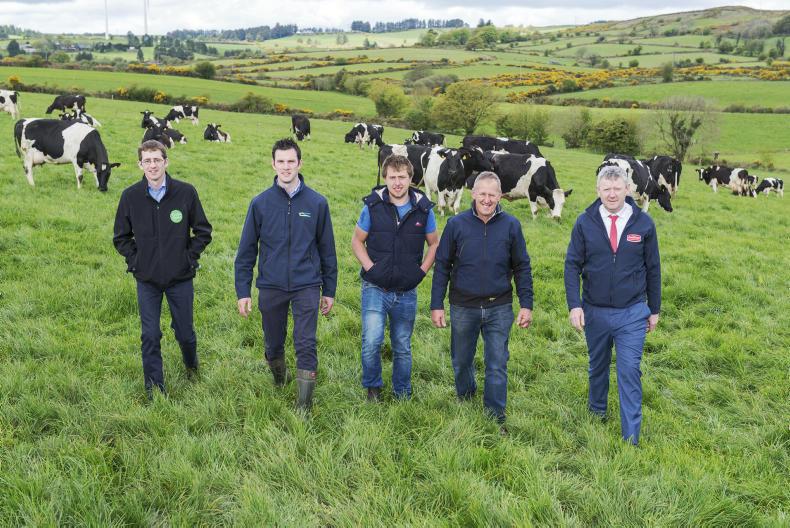
Pictured at a dairy sustainability open day on the farm of Origin Green Farmer Award winners and Dairygold milk suppliers Trevor and Olive Crowley of Lissarda, County Cork are Michael Houlihan, Bord Bia, Stuart Childs, Teagasc, hosts Gavin & Trevor Crowley & Billy Cronin, Dairygold. Photo O'Gorman Photography.
The Dairygold average is €98. Teagasc specialist Stuart Childs said that if the Crowleys could get EBI to the national average level, then overall profit should increase by €4,000 or €5,000 per year.
“It will also reduce the farm’s carbon footprint. Research says that for every €10 increase in herd EBI, greenhouse gas emissions fall by 2% per unit of product. Despite the low EBI, the Crowley herd performs well, with 483kg of milk solids per cow sold last year and 505kg/cow produced,” he said.
Eleanor Murphy from Bord Bia went through the Crowleys’ SDAS audit. She outlined the new reporting system for farm emissions.
The reports are based on emissions per kilo of fat- and protein-corrected milk. While cow numbers increased by 8% since the last audit, overall emissions decreased by 7%. Milk production increased by 10%. There was a 30% reduction in chemical nitrogen spread as all of the slurry was spread by a trailing shoe.
However, Trevor still lost some points because less slurry than normal was spread in the spring of 2018 due to poor ground conditions. There was a 5% increase in the grazing season to 292 days in 2017.
The three biggest contributors to the Crowleys’ emissions are animal digestion (methane), slurry management (ammonia) and chemical fertiliser.
The farm is soil sampled every three years and lime is spread where necessary. All the fertiliser is spread by Trevor and Gavin in a new GPS-calibrated fertiliser spreader.
Water quality
Ciara Donovan from Dairygold spoke about water quality. She said only 57% of Ireland’s rivers meet the EU standards and that the last water quality report showed a 3% decline between 2015 and 2017.
She said farming is the biggest pressure in the at-risk areas, because most rivers flow through farmland.
Over 70% of the water in rivers comes from groundwater, with only 30% coming from overland flow or run-off. As nitrogen leaches through the soil to the groundwater, it’s a significant risk.
Ciara outlined the steps the Crowleys have taken to protect water quality.
1 There’s a lake in a valley with steep fields sloping into it. No slurry is ever spread on these fields and chemical fertiliser is only spread when conditions are ideal.2 They keep back 2m from every field boundary when spreading chemical fertiliser and 5m back from drains when spreading slurry. 3 Areas along watercourses were fenced off when the farm was in REPS and these overgrown areas are now acting as buffer strips, catching nutrients before they enter the water.4 The farm has three weeks’ extra slurry storage so slurry is only spread with the trailing shoe when conditions are suitable.5 Fields are soil sampled every three years and slurry is targeted at the low-index fields.6 All grey water from the farmyard is collected. A diversion trap with an inspection point allows Trevor to assess the run-off before deciding to divert it to the clean water outlet.7 Most water troughs are located more than 20m from a watercourse and run-off from roadways doesn’t enter drains or watercourses.Biodiversity
Daire O hUallachain from Teagasc spoke about biodiversity. Biodiversity is the name given to the variety and variability of life and habitats.
The more variable the land use is, the higher the biodiversity. Daire said there are five main reasons why biodiversity is important for Irish farmers;
“The first thing is people want biodiversity. Society doesn’t want continuous fields of grass or crops. We want variety as this is more interesting and it’s better for wildlife.
"Secondly, biodiversity improves water quality as trees and scrub alongside rivers and streams prevent soil erosion and trap nutrients.
“Thirdly, trees and hedgerows sequester carbon, which is important in the combat of global warming. Finally, it’s good for tourism and farming with high levels of biodiversity brings marketing and branding opportunities.”
Daire said about 7% of the area on most intensive dairy farms is semi-natural habitat. Curtins Farm in Fermoy has 5% habitat while the main farm in Moorepark has 12% of the area as habitat. He said the next round of CAP is likely to see designated habitat areas come into law. The current CAP includes 5% mandatory habitat area on tillage farms and he said this is likely to increase in the next round.
Payments won’t be based just on quantity. The quality of the habitat will come into focus also, with tiered payments based on quality.
He cited the BRIDE project in Cork where farmers were trained to assess the quality of their habitats and incentivised to improve them.
He complimented the Crowleys on the quality of the biodiversity on their farm. Gaps in hedgerows have been filled in and new hedgerows planted. Existing hedgerows are thick and full of life.
Daire said neat, tidy and uniform hedges are not what is required from a biodiversity point of view. He said ideally the tops of hedges should never be cut, but the sides should be trimmed to keep them bushy and thick at the base.
William O’Halloran from Wild Work spoke about pollinators and the threat of extinction hanging over many pollinators such as honeybees, solitary bees, hoverflies and bumblebees.
He said there are three main reasons why they are in decline. They’re homeless, because their habitats have been removed; they’re hungry because their food source (flowers) isscarce; and they’ve been poisoned by pesticides.
Improving biodiversity is an absolute no-brainer
Driving away from the walk, the three things I took home were that sustainability revolves around emissions, water quality and biodiversity.
All three are being measured and all three will be measured more in the future. In my view, none are a threat to grass-based dairy farming.
The new emissions report on the SDAS will be a game-changer for the way Irish farmers look at emissions.
The farmers with the lowest emissions will be the ones that have the highest EBI cows, utilise the most grass, have clover in their swards, are prudent with fertiliser and use as little diesel as possible. These farmers will also be the most profitable.
Water quality is a concern. If it doesn’t improve, there will more than likely be a restriction on stocking rate, even though that probably won’t solve the problem.
Do farmers realise that seepage from their neighbour’s farm could put their farm out of business? Extra conditions, or worse again the withdrawal of the Nitrates Derogation will seriously jeopardise the profitability of dairy farming in Ireland.
Maintaining and improving biodiversity on Irish dairy farms is an absolute no-brainer. You can’t see emissions or water quality, but you can see biodiversity and so too can consumers.
No other dairy producing country in the world feeds their cows grass and has a high quantity and quality of biodiversity. Both of these are our competitive advantage. Irish produce can command a premium and this should be passed back to the producer.
With sustainability in mind, it’s baffling that many dairy farmers are going down the less-sustainable road of higher-input systems.
Feeding 3kg or 4kg of meal in May is now the norm on many farms and most will feed over 1t of meal per cow again this year.
This is great news for people selling inputs, but doesn’t leave more profit for farmers and is bad for the environment. Recent Teagasc dairy advisory publications give strong advice on what beef bulls to use, but shy away from advising on how much meal to feed.
With so much flux in the industry, farmers need strong advice and leadership on how to farm profitably and sustainably. There seems to be a lack of joined-up thinking at present.
For a long time, Ireland’s dairy farmers were told that their competitive advantage was the grass-based production system. The fact that our cows can graze grass means that we have the potential to be one of the lowest-cost milk producers in the world.
Lately, we’re also hearing that Irish farmers are among the most sustainable in the world. What does sustainable mean and is it worth chasing or is it just a marketing slogan?
Dairygold, Teagasc and Bord Bia held a farm walk last Friday on the Crowley farm near Lissarda, Co Cork. The Crowleys won the most-reduced carbon footprint award at the Origin Green awards last year.
They are milking over 150 cows in one of the most intensively farmed parts of Ireland and it was brilliant to see a large, well-run, profitable farm that was also considered sustainable.
Yet, the crowd were told the farm could become even more sustainable. The herd EBI is below average at €89.

Pictured at a dairy sustainability open day on the farm of Origin Green Farmer Award winners and Dairygold milk suppliers Trevor and Olive Crowley of Lissarda, County Cork are Michael Houlihan, Bord Bia, Stuart Childs, Teagasc, hosts Gavin & Trevor Crowley & Billy Cronin, Dairygold. Photo O'Gorman Photography.
The Dairygold average is €98. Teagasc specialist Stuart Childs said that if the Crowleys could get EBI to the national average level, then overall profit should increase by €4,000 or €5,000 per year.
“It will also reduce the farm’s carbon footprint. Research says that for every €10 increase in herd EBI, greenhouse gas emissions fall by 2% per unit of product. Despite the low EBI, the Crowley herd performs well, with 483kg of milk solids per cow sold last year and 505kg/cow produced,” he said.
Eleanor Murphy from Bord Bia went through the Crowleys’ SDAS audit. She outlined the new reporting system for farm emissions.
The reports are based on emissions per kilo of fat- and protein-corrected milk. While cow numbers increased by 8% since the last audit, overall emissions decreased by 7%. Milk production increased by 10%. There was a 30% reduction in chemical nitrogen spread as all of the slurry was spread by a trailing shoe.
However, Trevor still lost some points because less slurry than normal was spread in the spring of 2018 due to poor ground conditions. There was a 5% increase in the grazing season to 292 days in 2017.
The three biggest contributors to the Crowleys’ emissions are animal digestion (methane), slurry management (ammonia) and chemical fertiliser.
The farm is soil sampled every three years and lime is spread where necessary. All the fertiliser is spread by Trevor and Gavin in a new GPS-calibrated fertiliser spreader.
Water quality
Ciara Donovan from Dairygold spoke about water quality. She said only 57% of Ireland’s rivers meet the EU standards and that the last water quality report showed a 3% decline between 2015 and 2017.
She said farming is the biggest pressure in the at-risk areas, because most rivers flow through farmland.
Over 70% of the water in rivers comes from groundwater, with only 30% coming from overland flow or run-off. As nitrogen leaches through the soil to the groundwater, it’s a significant risk.
Ciara outlined the steps the Crowleys have taken to protect water quality.
1 There’s a lake in a valley with steep fields sloping into it. No slurry is ever spread on these fields and chemical fertiliser is only spread when conditions are ideal.2 They keep back 2m from every field boundary when spreading chemical fertiliser and 5m back from drains when spreading slurry. 3 Areas along watercourses were fenced off when the farm was in REPS and these overgrown areas are now acting as buffer strips, catching nutrients before they enter the water.4 The farm has three weeks’ extra slurry storage so slurry is only spread with the trailing shoe when conditions are suitable.5 Fields are soil sampled every three years and slurry is targeted at the low-index fields.6 All grey water from the farmyard is collected. A diversion trap with an inspection point allows Trevor to assess the run-off before deciding to divert it to the clean water outlet.7 Most water troughs are located more than 20m from a watercourse and run-off from roadways doesn’t enter drains or watercourses.Biodiversity
Daire O hUallachain from Teagasc spoke about biodiversity. Biodiversity is the name given to the variety and variability of life and habitats.
The more variable the land use is, the higher the biodiversity. Daire said there are five main reasons why biodiversity is important for Irish farmers;
“The first thing is people want biodiversity. Society doesn’t want continuous fields of grass or crops. We want variety as this is more interesting and it’s better for wildlife.
"Secondly, biodiversity improves water quality as trees and scrub alongside rivers and streams prevent soil erosion and trap nutrients.
“Thirdly, trees and hedgerows sequester carbon, which is important in the combat of global warming. Finally, it’s good for tourism and farming with high levels of biodiversity brings marketing and branding opportunities.”
Daire said about 7% of the area on most intensive dairy farms is semi-natural habitat. Curtins Farm in Fermoy has 5% habitat while the main farm in Moorepark has 12% of the area as habitat. He said the next round of CAP is likely to see designated habitat areas come into law. The current CAP includes 5% mandatory habitat area on tillage farms and he said this is likely to increase in the next round.
Payments won’t be based just on quantity. The quality of the habitat will come into focus also, with tiered payments based on quality.
He cited the BRIDE project in Cork where farmers were trained to assess the quality of their habitats and incentivised to improve them.
He complimented the Crowleys on the quality of the biodiversity on their farm. Gaps in hedgerows have been filled in and new hedgerows planted. Existing hedgerows are thick and full of life.
Daire said neat, tidy and uniform hedges are not what is required from a biodiversity point of view. He said ideally the tops of hedges should never be cut, but the sides should be trimmed to keep them bushy and thick at the base.
William O’Halloran from Wild Work spoke about pollinators and the threat of extinction hanging over many pollinators such as honeybees, solitary bees, hoverflies and bumblebees.
He said there are three main reasons why they are in decline. They’re homeless, because their habitats have been removed; they’re hungry because their food source (flowers) isscarce; and they’ve been poisoned by pesticides.
Improving biodiversity is an absolute no-brainer
Driving away from the walk, the three things I took home were that sustainability revolves around emissions, water quality and biodiversity.
All three are being measured and all three will be measured more in the future. In my view, none are a threat to grass-based dairy farming.
The new emissions report on the SDAS will be a game-changer for the way Irish farmers look at emissions.
The farmers with the lowest emissions will be the ones that have the highest EBI cows, utilise the most grass, have clover in their swards, are prudent with fertiliser and use as little diesel as possible. These farmers will also be the most profitable.
Water quality is a concern. If it doesn’t improve, there will more than likely be a restriction on stocking rate, even though that probably won’t solve the problem.
Do farmers realise that seepage from their neighbour’s farm could put their farm out of business? Extra conditions, or worse again the withdrawal of the Nitrates Derogation will seriously jeopardise the profitability of dairy farming in Ireland.
Maintaining and improving biodiversity on Irish dairy farms is an absolute no-brainer. You can’t see emissions or water quality, but you can see biodiversity and so too can consumers.
No other dairy producing country in the world feeds their cows grass and has a high quantity and quality of biodiversity. Both of these are our competitive advantage. Irish produce can command a premium and this should be passed back to the producer.
With sustainability in mind, it’s baffling that many dairy farmers are going down the less-sustainable road of higher-input systems.
Feeding 3kg or 4kg of meal in May is now the norm on many farms and most will feed over 1t of meal per cow again this year.
This is great news for people selling inputs, but doesn’t leave more profit for farmers and is bad for the environment. Recent Teagasc dairy advisory publications give strong advice on what beef bulls to use, but shy away from advising on how much meal to feed.
With so much flux in the industry, farmers need strong advice and leadership on how to farm profitably and sustainably. There seems to be a lack of joined-up thinking at present.





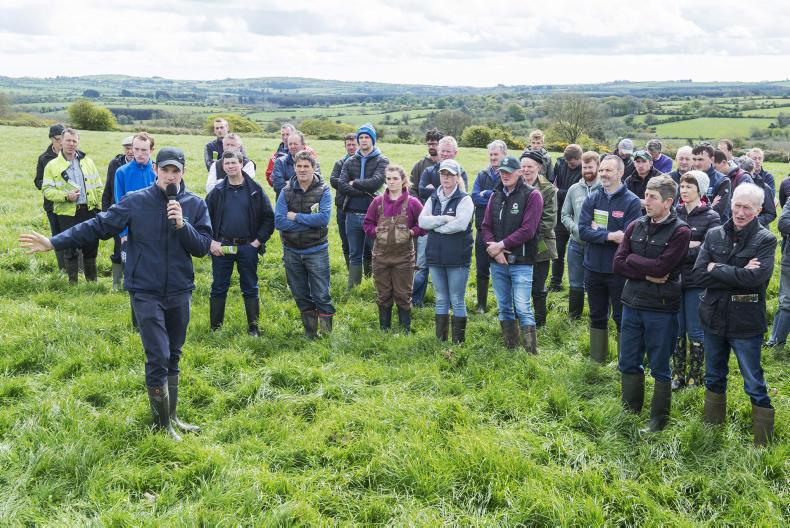
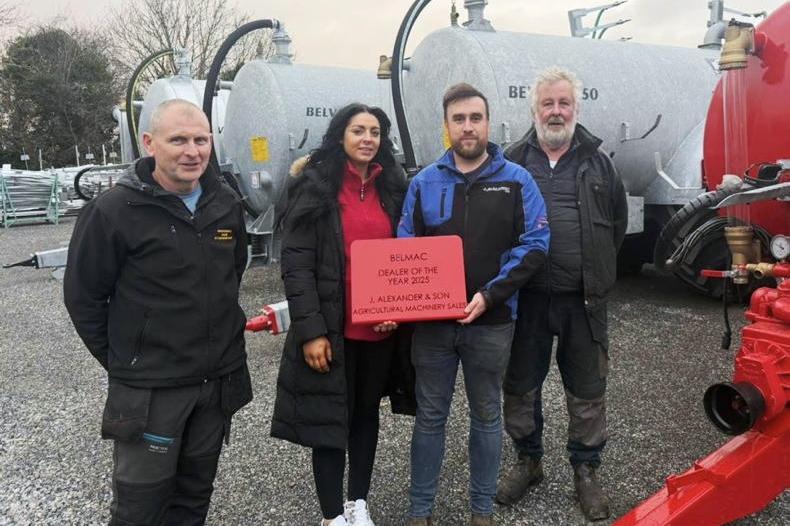
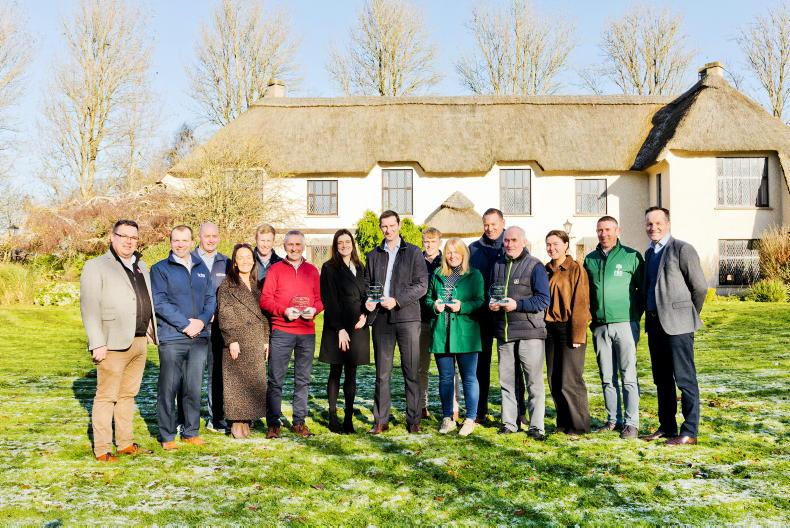
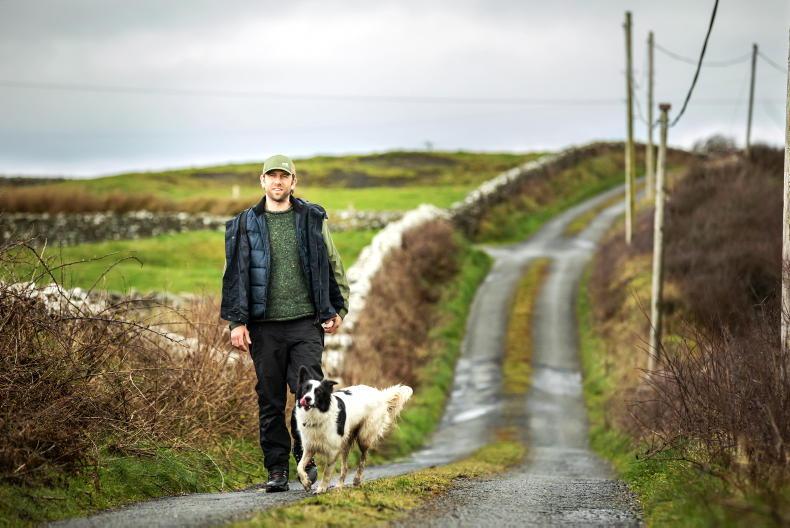
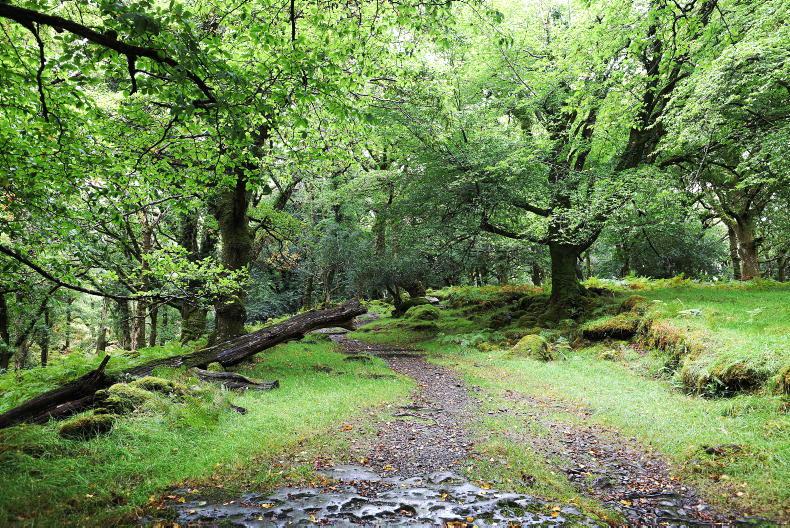
SHARING OPTIONS